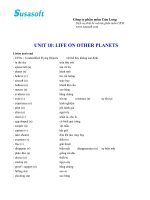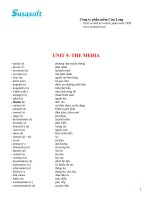từ vựng tiếng anh lớp 11 unit 11 - Sources of energy)
Bạn đang xem bản rút gọn của tài liệu. Xem và tải ngay bản đầy đủ của tài liệu tại đây (67.46 KB, 2 trang )
UNIT 11: SOURCES OF ENERGY
READING
1. alternative (a) thay thế
2. available [ə'veiləbl] (a) sẵn có
3. dam (n) đập (ngăn nước)
4. electricity [i,lek'trisiti] (n) điện
5. energy ['enədʒi] (n) năng lượng
6. exhausted (a) cạn kiệt
7. fossil fuel (n) nhiên liệu hóa thạch
8. geothermal heat [,dʒi:ou'θə:məl hi:t] (n) địa nhiệt
9. infinite ['infinit] (a) vô hạn
10. make use of (exp) tận dụng
11. nuclear energy ['nju:kliə] (a) năng lượng hạt nhân
12. plentiful ['plentifl] (a) nhiều
13. power demand (n) nhu cầu sử dụng điện
14. release [ri'li:s] (v) phóng ra
15. reserve [ri'zə:v] (n) trữ lượng
16. solar energy ['soulə] (n) năng ượng mặt trời
17. solar panel ['pænl] (n) tấm thu năng lượng mặt trời
18. windmill ['winmil] (n) cối xay gió
19. convenient [kən'vi:njənt] (a) tiện lợi
20. enormous (a) to lớn, khổng lồ
21. harmful (a) có hại
22. hydroelectricity [,haidrouilek'trisiti] (n) thủy điện
23. nuclear reactor [ri:'æktə] (n) phản ứng hạt nhân
24. radiation [,reidi'ei∫n] (n) phóng xạ
25. renewable [ri'nju:əbl] (a) có thể thay thế
26. run out (v) cạn kiệt
27. ecologist (n) nhà sinh thái học
28. ecology (n) sinh thái học
29. fertilize ['fə:tilaiz] (v) bón phân
30. replace [ri'pleis] (v) thay thế
31. consumption (n) sự tiêu thụ
32. make up (v) chiếm (số lượng)
33. conduct (v) tiến hành
34. experiment [iks'periment] (n) cuộc thí nghiệm
35. extraordinary (a) lạ thường
36. locate [lou'keit] (v) nằm ở
37. → location (n) vị trí
38. progress ['prougres] (n) sự tiến triển
39. surround [sə'raund] (v) bao quanh
LISTENING
renewable – Ecologists - fertilized – unlimited – supply - nonrenewable - correct amount
The natural environment includes all natural resources that are necessary for life the air, the oceans,
the sun, and the land. Because they are vital for life, these resources must be protected from pollution and
conserved. (1) …………… study their importance and how to use them carefully.
According to ecologists, resources are divided into two groups: (2) ………………… and
nonrenewable .When a resource is used , it takes some time to replace it . If the resources can be replaced
quickly, it is called renewable. If it cannot be replaced quickly and easily, it is nonrenewable. For
example, grass for animals is a renewable resource. When cows eat the grass, the resource is used. If the
soil is (3) ……………… and protected, more grass will grow. Coal, However, is (4) …………………
because it takes millions of years to make coal. All fossil fuels are nonrenewable resources.
Solar energy, air and water are renewable resources because there is an (5) ……………… (6)
…………………….However, this definition may change if people are not careful with these resources.
The amount of solar energy that reaches the Earth depends on the atmosphere. If the atmosphere is
polluted, the solar energy that reaches the earth may be dangerous. If life is going to continue, the air must
contain the (7) ………………. of nitrogen (N), oxygen (O), carbon dioxide
(CO
2
) and other gases. If humans continue to pollute the air, it will not contain the correct amounts of
these gases.









